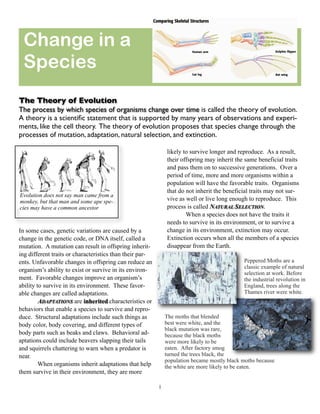
Homologous Structures
- 1. Change in a Species The Theory of Evolution The process by which species of organisms change over time is called the theory of evolution. A theory is a scientific statement that is supported by many years of observations and experi- ments, like the cell theory. The theory of evolution proposes that species change through the processes of mutation, adaptation, natural selection, and extinction. likely to survive longer and reproduce. As a result, their offspring may inherit the same beneficial traits and pass them on to successive generations. Over a period of time, more and more organisms within a population will have the favorable traits. Organisms that do not inherit the beneficial traits may not sur- Evolution does not say man came from a monkey, but that man and some ape spe- vive as well or live long enough to reproduce. This cies may have a common ancestor process is called NATURAL SELECTION. When a species does not have the traits it needs to survive in its environment, or to survive a In some cases, genetic variations are caused by a change in its environment, extinction may occur. change in the genetic code, or DNA itself, called a Extinction occurs when all the members of a species mutation. A mutation can result in offspring inherit- disappear from the Earth. ing different traits or characteristics than their par- ents. Unfavorable changes in offspring can reduce an Peppered Moths are a classic example of natural organism’s ability to exist or survive in its environ- selection at work. Before ment. Favorable changes improve an organism’s the industrial revolution in ability to survive in its environment. These favor- England, trees along the able changes are called adaptations. Thames river were white. ADAPTATIONS are inherited characteristics or behaviors that enable a species to survive and repro- duce. Structural adaptations include such things as The moths that blended body color, body covering, and different types of best were white, and the black mutation was rare, body parts such as beaks and claws. Behavioral ad- because the black moths aptations could include beavers slapping their tails were more likely to be and squirrels chattering to warn when a predator is eaten. After factory smog near. turned the trees black, the population became mostly black moths because When organisms inherit adaptations that help the white are more likely to be eaten. them survive in their environment, they are more 1
- 2. Evidence These processes of species change have occurred over long periods of time on the Earth, which scientists believe may be close to 4.6 billion years old. We have learned about the age of the Earth and its changing inhabitants by studying rocks and the remains of plants and animals preserved in rocks. These remains are called Fossils. Genetic Similarities Scientists also use evidence from genetic information to support the theory of evolution. They compare the DNA of different species and can tell how closely they are related by the number of similarities they find. Scientists believe that organisms with similar genes are de- scended from a common ancestor. For example scientists believe that bears and raccoons come from a common ancestor that lived over 40 million years ago. Distribution of Organisms The distribution of organisms on Earth is also used as evidence for the theory of evolution. Scientists have found that there is an unequal distribution of organisms on Earth. A species that is found in a particular ecosystem, such as cacti in the deserts of North America, is not found in a similar ecosystem such as the deserts of Africa. Scientists believe that each species originated or began in one location and from this point of origin spread out until it was stopped by a physical geographic barrier such an ocean, an environ- mental barrier such as a colder climate, or an ecological barrier such as competition from another species. Anatomical Evidence Anatomical evidence is also used to support the theory of evolution. Scientists study the similarities in body structure among different species such as whales and humans. Such similarities as skeletal structure provide evidence that two very different organisms may have evolved from a common ancestor. HOMOLOGOUS STRUCTURES are body parts that are structurally similar in related species; these provide evidence for a common ancestor. These homologous structures are also linked to common DNA. Homologous structures include a dolphins front flipper, a human arm, a bat’s wing and a rats foreleg. All have different purposes and look different on the outside, but the underlying bone structure is very similar. This is different from a bat’s wing and a bee’s wing - which have similar function (to fly) but very different structures. 2
